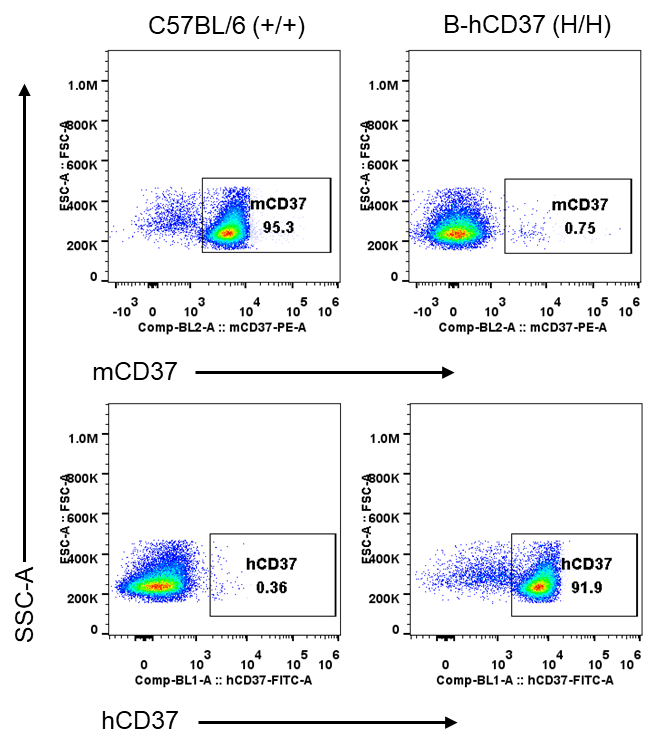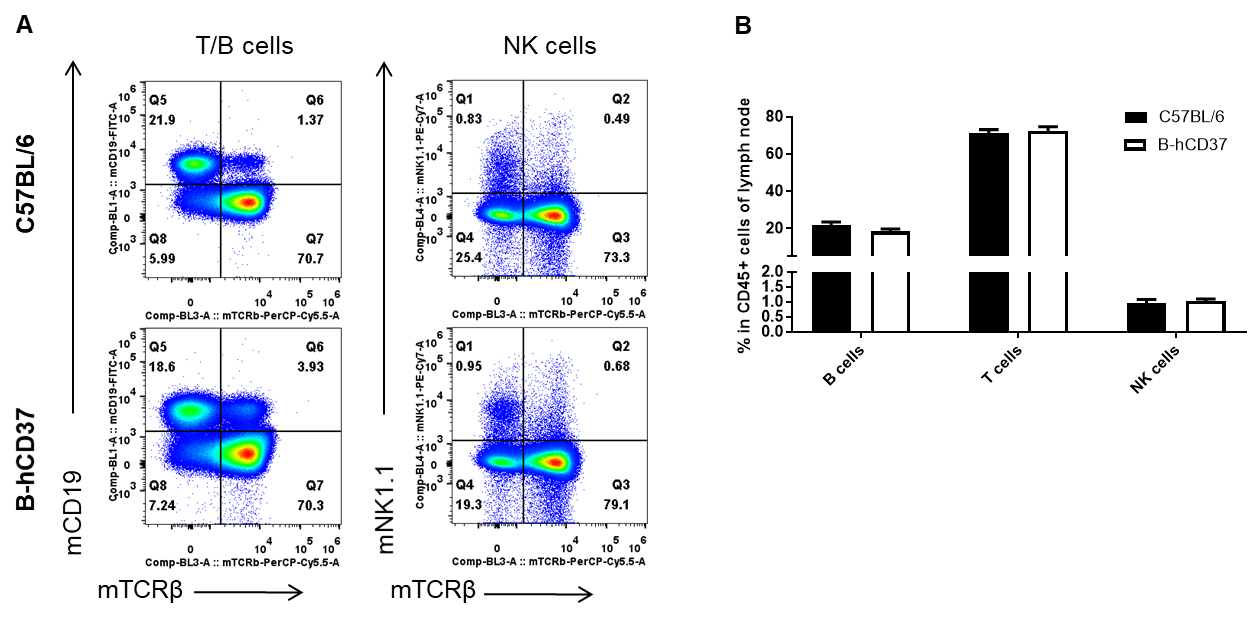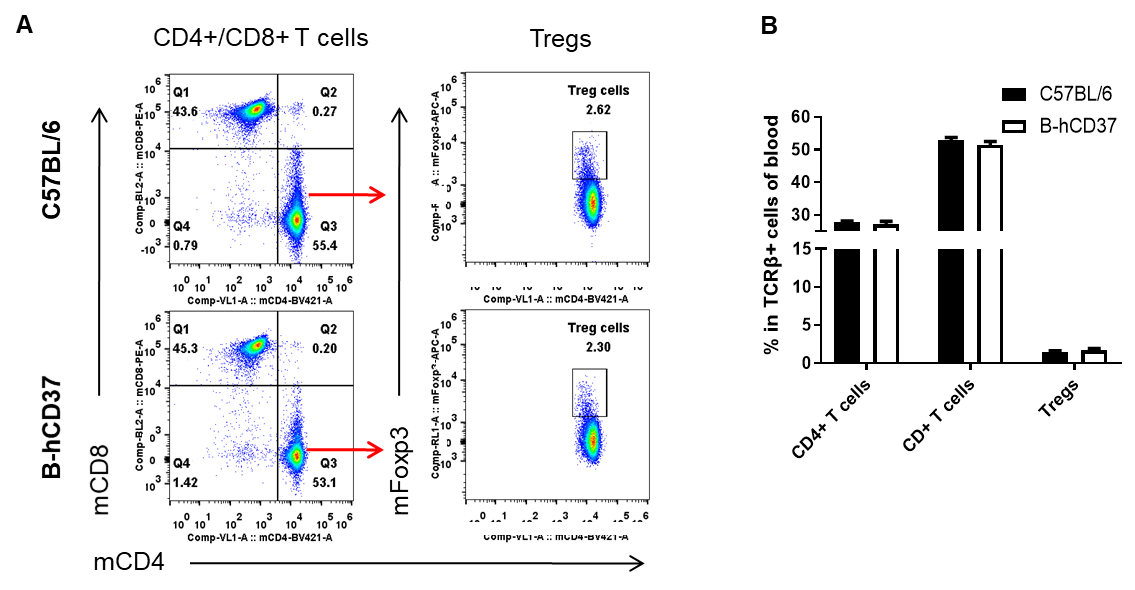Basic Information
-
Targeting strategy

-
Gene targeting strategy for B-hCD37 mice. The exons 2-8 of mouse Cd37 gene which encode the full coding sequences except for the signaling peptide were replaced with human CD37 exons 2-8 in B-hCD37 mice.
-
mRNA expression analysis

-

Strain specific analysis of CD37 gene expression in wild-type C57BL/6 mice and homozygous B-hCD37 mice by RT-PCR. Mouse Cd37 mRNA was detectable in splenocytes of wild-type C57BL/6 mice (+/+). Human CD37 mRNA was detectable only in homozygous B-hCD37 mice (H/H) but not in wild-type mice.
-
Protein expression analysis

-

Strain specific CD37 expression analysis in wild-type C57BL/6 mice and homozygous B-hCD37 mice by flow cytometry. Splenocytes were collected from wild-type C57BL/6 mice (+/+) and homozygous B-hCD37 mice (H/H) and B cells were selected with anti-mCD19 antibody. Mouse CD37 was detectable only in wild-type mice. Human CD37 was detectable only in homozygous B-hCD37 mice.
-
Analysis of leukocytes cell subpopulation in spleen

-

Analysis of spleen leukocyte subpopulations by FACS. Splenocytes were isolated from female C57BL/6 and B-hCD37 mice (n=3, 6-week-old). Flow cytometry analysis of the splenocytes was performed to assess leukocyte subpopulations. A. Representative FACS plots. Single live cells were gated for the CD45+ population and used for further analysis as indicated here. B. Results of FACS analysis. Percent of T cells, B cells, NK cells, dendritic cells, granulocytes, monocytes and macrophages in homozygous B-hCD37 mice were similar to those in the C57BL/6 mice, demonstrating that introduction of hCD37 in place of its mouse counterpart does not change the overall development, differentiation or distribution of these cell types in spleen. Values are expressed as mean ± SEM.
-
Analysis of T cell subpopulation in spleen

-

Analysis of spleen T cell subpopulations by FACS. Splenocytes were isolated from female C57BL/6 and B-hCD37 mice (n=3, 6-week-old). Flow cytometry analysis of the splenocytes was performed to assess leukocyte subpopulations. A. Representative FACS plots. Single live CD45+ cells were gated for TCRβ+ T cell population and used for further analysis as indicated here. B. Results of FACS analysis. The percent of CD4+ T cells, CD8+ T cells and Tregs in homozygous B-hCD37 mice were similar to those in the C57BL/6 mice, demonstrating that introduction of hCD37 in place of its mouse counterpart does not change the overall development, differentiation or distribution of these T cell subtypes in spleen. Values are expressed as mean ± SEM.
-
Analysis of leukocytes cell subpopulation in lymph node

-

Analysis of lymph node leukocyte subpopulations by FACS. Lymph nodes were isolated from female C57BL/6 and B-hCD37 mice (n=3, 6-week-old). Flow cytometry analysis of the leukocytes was performed to assess leukocyte subpopulations. A. Representative FACS plots. Single live cells were gated for the CD45+ population and used for further analysis as indicated here. B. Results of FACS analysis. Percent of T cells, B cells and NK cells in homozygous B-hCD37 mice were similar to those in the C57BL/6 mice, demonstrating that introduction of hCD37 in place of its mouse counterpart does not change the overall development, differentiation or distribution of these cell types in lymph node. Values are expressed as mean ± SEM.
-
Analysis of T cell subpopulation in lymph node

-

Analysis of lymph node T cell subpopulations by FACS. Leukocytes were isolated from female C57BL/6 and B-hCD37 mice (n=3, 6-week-old). Flow cytometry analysis of the leukocytes was performed to assess leukocyte subpopulations. A. Representative FACS plots. Single live CD45+ cells were gated for TCRβ+ T cell population and used for further analysis as indicated here. B. Results of FACS analysis. The percent of CD4+ T cells, CD8+ T cells, and Tregs in homozygous B-hCD37 mice were similar to those in the C57BL/6 mice, demonstrating that introduction of hCD37 in place of its mouse counterpart does not change the overall development, differentiation or distribution of these T cell subtypes in lymph node. Values are expressed as mean ± SEM.
-
Analysis of leukocytes cell subpopulation in blood

-

Analysis of blood leukocyte subpopulations by FACS. Blood cells were isolated from female C57BL/6 and B-hCD37 mice (n=3, 6-week-old). Flow cytometry analysis of the blood cells was performed to assess leukocyte subpopulations. A. Representative FACS plots. Single live cells were gated for the CD45+ population and used for further analysis as indicated here. B. Results of FACS analysis. Percent of T cells, B cells, NK cells, dendritic cells, granulocytes, monocytes and macrophages in homozygous B-hCD37 mice were similar to those in the C57BL/6 mice, demonstrating that introduction of hCD37 in place of its mouse counterpart does not change the overall development, differentiation or distribution of these cell types in blood. Values are expressed as mean ± SEM.
-
Analysis of T cell subpopulation in blood

-

Analysis of blood T cell subpopulations by FACS. Blood cells were isolated from female C57BL/6 and B-hCD37 mice (n=3, 6-week-old). Flow cytometry analysis of the blood cells was performed to assess leukocyte subpopulations. A. Representative FACS plots. Single live CD45+ cells were gated for TCRβ+ T cell population and used for further analysis as indicated here. B. Results of FACS analysis. The percent of CD4+ T cells, CD8+ T cells, and Tregs in homozygous B-hCD37 mice were similar to those in the C57BL/6 mice, demonstrating that introduction of hCD37 in place of its mouse counterpart does not change the overall development, differentiation or distribution of these T cell subtypes in blood. Values are expressed as mean ± SEM.
-
Summary

-
mRNA expression analysis:
Mouse Cd37 mRNA was detectable in splenocytes of wild-type mice. Human CD37 mRNA was detectable in homozygous B-hCD37 mice.
Protein expression analysis:
Mouse CD37 was detectable in wild-type mice. Human CD37 was exclusively detectable in homozygous B-hCD37 mice.
Leukocytes cell subpopulation analysis:
CD37 humanized does not change the overall development, differentiation or distribution of immune cell types in spleen, lymph node and blood.


